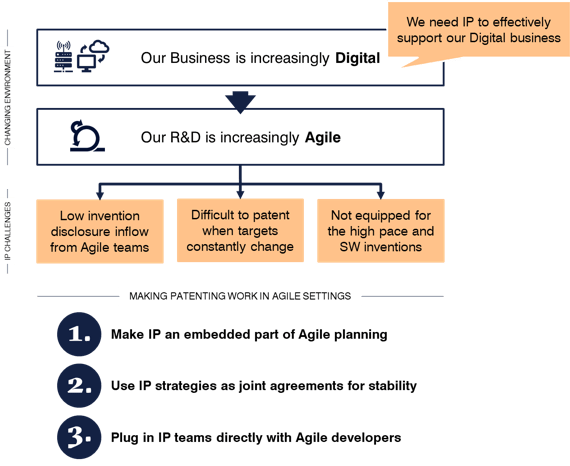Three Key Strategies for Adapting Patent Departments to Agile Innovation Settings

As companies grow their digital business, many R&D organizations transition to Agile innovation practices*, both in software and hardware development. Any implementation of Agile leads to key changes in how firms innovate. Changes include how R&D objectives are set, how resource prioritizations are made, and how fast development cycles are run. Instead of the traditional approach of setting goals early on and seeing changes as unwanted deviations from plan, Agile brings a state of constant evolution, as Agile teams find, solve and reformulate problems to create as much customer value as possible. Resource prioritization is more active and selective as Agile empowers and requires teams to direct resources to the features and unsolved problems with highest priority. Development cycles shorten as Agile emphasizes quick sprints with autonomous teams having end-to-end skills.
These changes tend to challenge traditional patent departments in fundamental areas:
- Motivating why development teams should spend time on IP creation when they are already fully utilized on top-priority tasks and patenting is seen as an afterthought,
- Directing patenting activities when development objectives evolve and change in the middle of projects, and
- Keeping up with a high pace of incremental output when patent processes are structured to support more static stage gate or waterfall models.
In addition, Agile innovation typically (though certainly not always) involves software development, which can be a challenge for a patent department that is unfamiliar with digital patents.

Figure 1: Three keys to overcome challenges and make patenting work in Agile innovation settings
The challenges outlined above have much in common with the challenges overcome by business-driven IP management. Therefore, IP organizations that have already taken steps to become proactive business partners usually find it easier to adapt to Agile. In our experience from helping to plan, build and staff business-driven IP organizations, we have identified three keys to help patent departments adapt to the challenges of Agile innovation.
1. Make IP an Embedded Part of Agile Planning
Agile innovation is all about producing more valuable output for the customer at higher speed. To do so, a key principle for Agile innovation is to prioritize activities and to consistently direct resources to the features and issues that are most important. For patenting to be considered a top priority, the IP organization must be able to provide a clear rationale for when and where IP is business critical. If the IP organization reactively takes action to capture inventions coming out as a biproduct of R&D, that business rationale will be very difficult to provide. As result, patenting will not be prioritized in high-paced and resource competitive Agile settings, and the IP portfolios that should support the company’s digital business growth will die on the vine.
What is needed is to upend the traditional patenting process and make sure IP is part of the strategic dialogue from the start. This means embedding IP on all levels of Agile planning: participating in investment decisions on the Agile Portfolio Level; supporting strategic decision making in the Program backlog and providing input to the priority setting process among activities in the iterative sprints of cross-functional Agile teams. By playing an active role in the planning, the IP organization can deepen its understanding of business needs and translate this into IP-specific needs. This lets the IP organization determine when IP will be business critical and when it is not.

Figure 2: Embed IP into the Agile planning on all levels. Illustration inspired by the Scaled Agile Framework *.
A lesson on successful integration of IP into the Agile planning cycle can be found in the recent IP department transformation of a major European automotive company. The company was gradually introducing Agile as the preferred mode of technology development in emerging areas. To ensure deep knowledge of business needs and priorities and proactively exercise influence at IP-critical milestones, the IP Portfolio Director met Epic Owners before each planning cadence to set priorities for the upcoming cycle. By being part of the strategic dialogue on the Agile Portfolio Level, the IP Portfolio Director could jointly identify epics where it was most crucial to carry out IP activities. She could then selectively engage with the IP-relevant Business Owners on Program level to anchor the business rationale and add IP tasks to program backlogs. Finally, she and her team engaged with Product Owners and Agile teams that had been assigned IP creation tasks to plan activities, provide support and ensure effective and efficient execution.
2. Use IP Strategies as Joint Agreements for Stability
Over the course of an Agile program the priorities of the program backlog will change frequently. When this happens, decisions are often made rapidly and what was relevant yesterday might be out of the picture today. In these rapid shifts, knowing where and when to spend resources on IP is key. This understanding also needs to be shared between the IP and R&D organizations.
To get to needed level of clarity and resilience, there must be a joint agreement between IP and R&D that ties the knot between business goals and IP portfolio needs. This joint agreement is typically set in the form of an IP strategy. When conditions change, the agreement creates stability and helps resource owners in the Agile train redirect resources to IP generation in the right areas. It also guides the IP organization on how to act proactively and keep up with the pace and variability of Agile innovation.

Figure 3: IP strategy as a joint agreement between IP and R&D connecting business goals and IP portfolio needs Illustration inspired by the Scaled Agile Framework *.
The joint agreement can be formalized in different ways. At a Nordic industrial company, the IP strategy and its execution were shared accountabilities between business and IP. When R&D changed the program backlog and new features were prioritized, there was an instant re-design of the IP task-list based on the IP counterpart’s understanding of the business rationale articulated in the joint agreement. At the same time, resource owners in the Agile train made sure the affected teams had corresponding time dedicated to patent generation.
3. Plug in IP Teams Directly with Agile Developers
Agile sprints are designed to progress quickly towards a goal, leaving little time for developers to document or even think about inventions. In combination with the patentability controversy surrounding software-based inventions, the result is often a reduced inflow of invention disclosures and few filed patent applications. When invention disclosure submission becomes dependent on the software patentability knowledge and interest of individual developers who must write invention disclosures during non-working hours, the right IP portfolios will most likely not be created.
A highly effective approach is to have dedicated IP teams with strong software skills and deep understanding of the business directly plugged in with Agile developers. The IP teams can pick up on the developments that are both patentable and in line with the IP strategy (i.e. the joint agreement). This will stimulate invention generation and capture patentable subject matter for the best possible outcome. When the Agile team backlog prioritizations change, the IP Team will have a clear set of directives on when to adapt, stand fast or escalate.

Figure 4: IP teams directly plugged-in with Agile developers; not reactively waiting for invention disclosures. Illustration inspired by the Scaled Agile Framework *.
By having IP professionals directly plugged-in with agile developers, rapid progress can be made. An example can be found at a European company venturing into the Industrial IoT space. To realize the needed fast growth of patent portfolios in a strategic area, the company allocated a patent attorney to be part of Agile team sprint planning meetings and retrospectives. The attorney acted as a “fly on the wall,” listening in and identifying potentially patentable inventions in line with the set IP strategy. By having participated directly in development discussions, the attorney could define the core of inventions and effectively collaborate with developers in drafting applications.
Why Agile Innovation Resonates with Business-Driven IP Management
The three keys outlined above all have their origin in the theory of business-driven IP management. A way of working which lets IP organizations upgrade to a proactive, business-partner-based model. Working according to this model readies the IP organization to effectively support an R&D transition to Agile innovation and realizing digital business growth, as it sets in place many of the fundamental prerequisites for delivering on the three keys.

Figure 5: Agile innovation and business-driven IP management resonate well as they share several fundamental principles
Business-driven IP organizations put value creation first, as they connect all IP activities directly to business objectives. They apply systems thinking to navigate business and technological complexity and focus resources where it matters the most. They are built on empowered autonomy with assigned business accountability for IP, and they rely on the intrinsic motivation of knowledge workers in cross-functional and dedicated teams that are embedded with their counterparts.
An example of applying the three keys together to create business-driven IP management and boost patent output from Agile innovation is shown in an emerging business area of an engineering company. The BA had a history of good patent output from its mechanical engineering focused R&D. As business shifted towards digital, the R&D organization started to work according to Agile practices, combining software and hardware engineering. The company increased its R&D investments, but the number of invention disclosures and patent applications dropped significantly. To break the negative trend and ensure that the IP being generated would effectively support the digital business, the IP organization implemented a business-driven way of working. The result was striking. Not only did the number of filed patent applications increase drastically from the two previous years, but the share of applications in areas identified as top important also soared.

Figure 6: Example of patenting output effects from business-driven IP management practices in Agile innovation settings
In Conclusion
As businesses increasingly go digital and R&D organizations increasingly go Agile, IP organizations are pressured to respond effectively. Challenges for patent departments supporting Agile development and digital growth include coping with the high speed of development, responding to rapidly changing objectives, and the ability to influence strict resource prioritizations. In addition, it most often adds new competence requirements related to software patenting.
Business-driven IP organizations typically boost their output and relevance when supporting Agile innovation as the two approaches share many fundamental principles. With our experience of building business-driven IP organizations, we have seen that there are three keys to adapting patent departments to meet the challenges of Agile innovation: making IP an embedded part of Agile planning, using IP strategies as joint agreements for stability in rapidly changing conditions, and plugging in IP teams directly with Agile developers.
IP organizations that have not yet adapted to Agile should seize the opportunity to critically evaluate their way of working and use the change momentum of Agile transformations to upgrade their approach. Not only does this help prevent a drop-off in patent output often associated with Agile transitions, but it also ensures that the resulting IP portfolios effectively support the company’s digital business growth.
* For a definition of Agile innovation practices see the Scaled Agile Framework. For illustrative purposes in this article we have also used illustrations inspired by the Scaled Agile Framework as an example of an Agile innovation framework. Read more at www.scaledagileframework.com.


